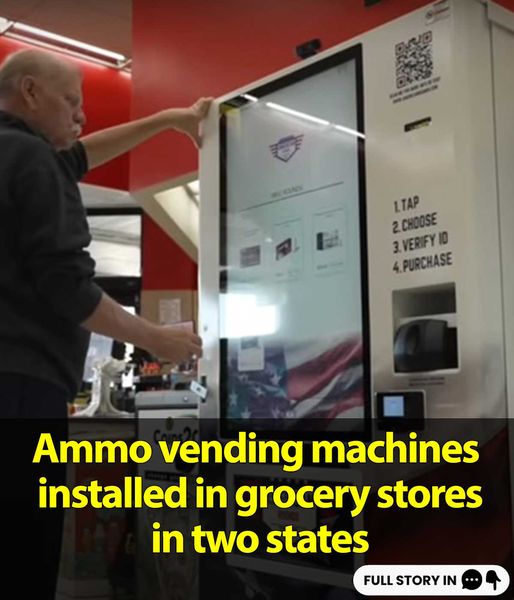Automated ammo vending machines have recently been installed in several grocery stores across Oklahoma and Alabama. This innovative approach to ammo sales, created by American Rounds, allows customers to purchase ammunition without engaging with store clerks, ensuring 24/7 accessibility. While this move has been met with both enthusiasm and concern, it represents a significant shift in how ammunition is distributed and sold in the U.S.
The Convenience of 24/7 Ammo Access

American Rounds’ ammo vending machines are designed to provide convenience and flexibility for ammunition buyers. According to the company’s website, these machines are accessible around the clock, allowing customers to buy ammo on their own schedule, free from the constraints of store hours and long lines. The machines offer a variety of handgun, rifle, and shotgun rounds, making it a one-stop shop for many gun owners.
Advanced Security Measures

One of the key features of these ammo vending machines is their advanced security technology. The machines are equipped with AI-powered card-scanning and facial-recognition software to verify the identity and age of each buyer.1 This technology ensures that all transactions comply with federal and local regulations. Grant Magers, CEO of American Rounds, explained that the ID scanners used are similar to those employed by the Transportation Security Administration (TSA) at airports, providing a high level of security.
No Limits on Purchases

Unlike traditional retail outlets, these ammo vending machines do not impose any limitations on the amount of ammunition one can purchase, except when the machines run out of stock.2 This makes them particularly appealing to frequent shooters and hunters who may need to stock up on large quantities of ammunition.
Expansion Plans

Currently, American Rounds has installed machines in locations across Oklahoma, Alabama, Texas, and soon, Colorado. Magers mentioned that there are plans to expand further, with over 200 store requests for the Automated Ammo Retail Machines (AARM) covering approximately nine states. This rapid expansion reflects the high demand and positive reception of this new sales method.
Mixed Reactions and Controversy

While many customers have praised the convenience and efficiency of the ammo vending machines, others have raised concerns about the increased ease of access to ammunition. Critics argue that such machines could potentially increase the risk of gun violence and accidental shootings, especially if the technology were to be hacked or malfunctioned.3
Nick Suplina, senior vice president for law and policy at Everytown for Gun Safety, expressed his concerns, stating, “In a country awash in guns and ammo, where guns are the leading cause of deaths for kids, we don’t need further to normalize the sale and promotion of these products”.4
Ensuring Responsible Sales

Magers emphasized that the company is committed to responsible gun ownership. He explained that the machines’ advanced security measures make them the safest and most secure method of purchasing ammo in the country. He also pointed out that the ammo vending machines were designed in response to requests from grocery stores in rural areas, where access to ammunition can be limited.
Potential Risks and Cybersecurity Concerns

Cybersecurity experts have noted potential risks associated with these ammo vending machines. Andrew Whaley, a senior technical director at Promon, highlighted that while the technology is likely subjected to rigorous security checks, it is not entirely hack-proof. He warned that vulnerabilities in the facial recognition software could be exploited by cybercriminals, leading to unauthorized purchases.
Conclusion

The introduction of ammo vending machines in grocery stores across Oklahoma and Alabama represents a significant shift in how ammunition is sold in the U.S. While the convenience and security features of these machines have been praised, there are valid concerns about their potential risks and impact on public safety. As the use of these machines expands, it will be crucial to monitor their effects and ensure that they are used responsibly.

Leave a Reply